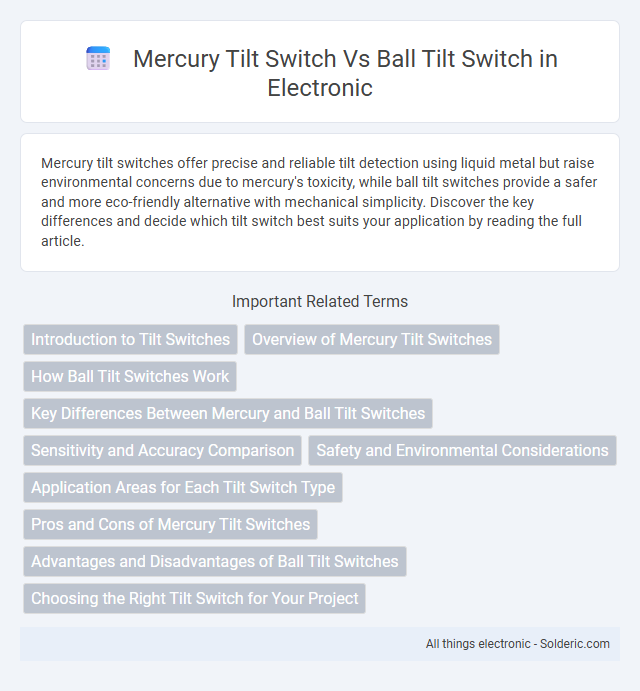Mercury tilt switches offer precise and reliable tilt detection using liquid metal but raise environmental concerns due to mercury's toxicity, while ball tilt switches provide a safer and more eco-friendly alternative with mechanical simplicity. Discover the key differences and decide which tilt switch best suits your application by reading the full article.
Comparison Table
| Feature | Mercury Tilt Switch | Ball Tilt Switch |
|---|---|---|
| Operating Principle | Mercury liquid completes electrical circuit when tilted | Conductive ball rolls to complete circuit on tilt |
| Material | Liquid mercury (toxic metal) | Conductive metal ball inside plastic or glass casing |
| Tilt Angle Sensitivity | Highly sensitive, precise activation | Moderate sensitivity, depends on ball size and enclosure |
| Durability | Fragile due to glass casing; risk of mercury leakage | Robust, less prone to breakage |
| Safety | Hazardous due to toxic mercury use | Non-toxic, safer for handling |
| Environmental Impact | Poor, mercury is environmentally harmful | Environmentally friendly |
| Cost | Generally higher due to mercury and manufacturing standards | Lower, simpler construction |
| Common Applications | Legacy electronics, thermostats, safety devices | Consumer electronics, toys, automotive sensors |
Introduction to Tilt Switches
Tilt switches detect changes in orientation by opening or closing electrical contacts based on angular movement. Mercury tilt switches use liquid mercury to complete the circuit when tilted, offering smooth and reliable operation with low contact resistance, while ball tilt switches rely on a rolling metal ball to make or break the connection, providing durability and resistance to vibration. Both types serve critical roles in safety devices, industrial controls, and consumer electronics, with their unique designs influencing sensitivity and environmental considerations.
Overview of Mercury Tilt Switches
Mercury tilt switches use a small amount of liquid mercury inside a sealed glass tube, which moves to complete or break an electrical circuit based on the device's orientation. These switches provide reliable, low-resistance connections and are highly sensitive to angle changes, making them ideal for applications requiring precise tilt detection. Mercury tilt switches are often preferred over ball tilt switches for their hermetic sealing and consistent electrical performance in harsh environments.
How Ball Tilt Switches Work
Ball tilt switches operate using a small conductive sphere that moves inside a sealed housing, completing or breaking an electrical circuit based on the device's orientation. Unlike mercury tilt switches that rely on liquid metal to connect contacts, ball tilt switches use the rolling motion of the ball to trigger the switch when tilted beyond a specific angle. Your choice between these switches should consider factors like sensitivity, environmental impact, and safety.
Key Differences Between Mercury and Ball Tilt Switches
Mercury tilt switches use a small amount of liquid mercury that flows to complete an electrical circuit when tilted, offering high reliability and precise orientation detection. Ball tilt switches employ a conductive metal ball inside a sealed housing that moves to make or break contact, providing simple construction and cost-effectiveness for basic tilt sensing. Key differences include mercury's environmental concerns and superior sensitivity versus the ball switch's mechanical simplicity and broader application range.
Sensitivity and Accuracy Comparison
Mercury tilt switches offer high sensitivity and precise accuracy due to the conductive mercury droplet responding swiftly to slight angular changes, making them ideal for applications requiring exact tilt detection. Ball tilt switches, while generally less sensitive, provide reliable performance with a mechanical rolling ball design that may introduce minor delays or inconsistencies in detecting subtle tilts. Your choice between these switches should consider the application's required sensitivity level, where mercury switches excel in precision but pose environmental concerns, whereas ball switches offer safer, lower-accuracy alternatives.
Safety and Environmental Considerations
Mercury tilt switches pose significant safety and environmental risks due to mercury's toxicity and potential for contamination if the device breaks. Ball tilt switches, using inert metals like steel or copper balls, offer a safer alternative with minimal ecological impact and reduced health hazards. Selecting ball tilt switches aligns with stringent environmental regulations and workplace safety standards aimed at reducing mercury exposure.
Application Areas for Each Tilt Switch Type
Mercury tilt switches are commonly used in industrial equipment, HVAC systems, and automotive safety devices due to their precise angle detection and reliable contact closure. Ball tilt switches find applications in consumer electronics, toys, and small appliances where durability and low power consumption are prioritized. Your choice depends on the specific environment and sensitivity requirements of the application area.
Pros and Cons of Mercury Tilt Switches
Mercury tilt switches provide precise and reliable operation with minimal contact wear, making them ideal for sensitive angle detection in industrial and automotive applications. Their main drawbacks include environmental concerns due to mercury toxicity and limitations in orientation sensitivity, as they only activate at specific tilt angles. Compared to ball tilt switches, mercury variants offer better stability but require careful handling and disposal to meet safety regulations.
Advantages and Disadvantages of Ball Tilt Switches
Ball tilt switches offer durable performance with no risk of mercury toxicity, making them environmentally safer than mercury tilt switches. Their simple design enables reliable operation in harsh vibrations and varying orientations, but they tend to have slower response times and may be less sensitive compared to mercury switches. You should consider these trade-offs when selecting a tilt switch for applications requiring robust, eco-friendly solutions.
Choosing the Right Tilt Switch for Your Project
Mercury tilt switches offer reliable and stable performance with minimal friction, making them ideal for precise angle detection in sensitive electronic projects. Ball tilt switches provide cost-effective, durable solutions suitable for rough environments where vibration and shock are common. Choosing the right tilt switch depends on factors like sensitivity, environmental conditions, and safety requirements--mercury switches excel in precision, while ball switches are favored for robustness.
Mercury tilt switch vs Ball tilt switch Infographic

 solderic.com
solderic.com